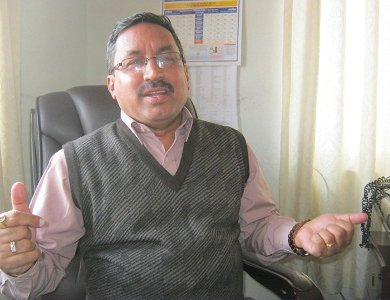
With a long experience of work in the local bodies, Suresh Acharya, president of MIREST-Nepal, spoke to New SPOTLIGHT about the new programs directed to make the local bodies accountable.
What is the importance of the program?
Our aim is to make the local bodies election a national agenda. We have already conducted several programs, including 220 at leadership level, and 400 RTI related activities. Some 1055 participated in interactions. We have already trained more than 12000 and mobilized 20,000 people in local governance discourse in the last six months. We have shared the knowledge of local governance and accountability with the people.
How do you intervene with the program?
The program includes public hearing, interactive television program, and use of RTI tool in rural areas to make the local bodies accountable. Along with the local bodies, we are also working to make the devolved bodies like livestock, education and health units, making them accountable to the people. MIREST-Nepal has a 20-point modality for accountability. We also organize programs to improve service delivery.
Where have you introduced the RTI component?
In Rattanchura VDC and Kamala Mai Municipality. We have already implemented the Right to Information component there. To enhance the capacity of change agents like social mobilizers and journalists, MIREST is organizing refresher courses. Public hearing and public audit are important components of our program. We have been doing the right to information sessions in all seven districts. We are publishing the exercise books of each district separately.
VDC secretaries have more responsibility than the parliamentarians at the center. VDC secretaries can decide whether one can be a citizen of Nepal or not. They recommend citizenship. There are 3915 VDCs and a secretary is given to look at two or three VDCs. There are still 800 seats of secretary vacant in VDCs. As there are no elected representatives, a secretary has to perform the role of planning as well as implementation.
What is MIREST-Nepal’s role in this context?
MIREST-Nepal focuses on local bodies. However, there is an oversight mechanism as well. There are various executive mechanisms in various levels, prime minister at the center, VDC chair at village level and DDC chair at district level. There are many mechanisms to see all this functions. The Commission for Investigation of the Abuse of Authority remained vacant for many years, National Vigilance Commission has not been given any role as per its mandate, and National Information Commission is now without commissioners. There are 12 oversight mechanisms. They are constitutionally and legally created but most of them are dysfunctional. The parliament is the key oversight mechanism of the country. It is unfortunate that there is no parliament.
What tools are you using now?
At a time when the legal mechanism has weakened, MIREST-Nepal has been launching campaigns using various medium of social accountability mechanism to make the local bodies accountable. We exercise social accountability tools from grass-root levels. MIREST-Nepal’s program focuses seven districts. In eastern Nepal, our program focuses on Sankhuwasabha, Sunsari, and Sindhuli. We also have Mustang, Dang, Humla and Kanchanpur. We cover seven district headquarters, three municipalities and 21 VDCs.
What are the highlights of your program?
We are launching public communication to enhance accountability. Public communication includes public hearing, and interactive TV sessions at grass-root level. This is a forum where local people can give their voices to send up to policy level at the center.
Do you mobilize other forces?
We also mobilize local journalists and change agents or social agents and use the tool of Right to Information to make the local bodies and employees of service delivery institutions accountable. This is just a preliminary stage. Not only the local people, even media persons working in rural Nepal need to know about the right to information. We need to do a big advocacy for right to information.
Where can you use RTI?
RTI can be used to make institutions accountable. We have also organized various training in these seven districts to enhance capability of local people and media persons. We have trained 400 people on RTI and leadership at the local level.
- TANAHU HYDROPOWER PROEJCT: A Significant Achievement
- Apr 15, 2024
- AMBASSADOR HANAN GODAR: Sharing Pain With A Nepali Family
- Mar 30, 2024
- VISIT OF KfW AND EIB TO NEPAL : Mission Matters
- Mar 25, 2024
- NEPAL BRITAIN SOCIETY: Pratima Pande's Leadership
- Mar 24, 2024
- NEPAL ARMY DAY: Time To Recall Glory
- Mar 15, 2024
















